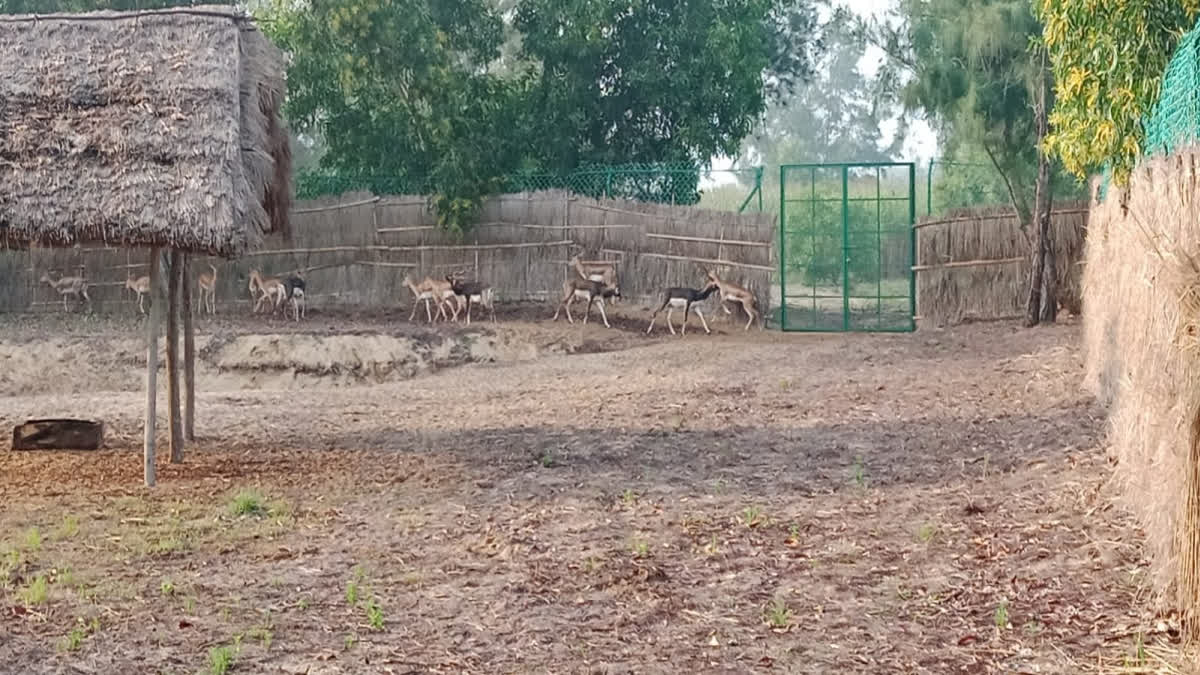Puri: Had it not been for actor Salman Khan, who is embroiled in the Blackbuck hunting controversy since September of 1998, the endangered Indian antelopes may not have got the attention they deserved, as a 'nearly threatened species'. From being massively hunted during pre-Independence till attaining an endangered status, the blackbucks have come back to focus, with conservation efforts increasing across the country, though they are predominantly found in Gujarat, Punjab, Rajasthan and Haryana.
In one such ambitious conservation effort, the Puri Forest Department started a project last year to revive the Blackbuck population in Balukhand Sanctuary but despite controlled conditions, the project is teetering on failure with nine of them dying between November and December 2024.
While the exact cause remains unclear, the bodies of the blackbucks have been sent to Orissa University of Agriculture and Technology (OUAT) in Bhubaneswar for examination. Environmentalists, however, suspect that inadequate habitat conditions, poor management, and inexperienced staff could be the contributing factors.
On June 18, 2024, the Forest Department brought 10 rare Blackbucks, including six females and four males, from Nandankanan to Konark Balukhand forest in the first phase with the aim of increasing their population. They were kept in a special enclosure built on an 10-acre area near Khandia Nai under Kurujang panchayat, 3 km from the main road of Kakatpur model school.
After getting acclimatized, they were freed to roam in the sanctuary. In the second phase, the department brought 13 rare black deer, including seven males and six females, from Nandankanan on September 19, 2024. Finally, on September 27, 2024, two more were brought accounting for a total of 25 Blackbucks which were released in the forest and the department kept a close watch on them.
Even in the first week of January, three black deer, including two females and one male were released from the forests of Ganjam and accommodated in a second enclosure in the Chitreswari sanctuary in Konark.
On the deaths of nine blackbucks, experts say, the species could not adapt to the environment of the Balukhand Sanctuary which is not conducive. Besides, they alleged that inexperienced forest staff and management errors could also have led to the deaths. However, the forest department has attributed some of the deaths to pneumonia.
Environmentalist Saroj Kumar Jena said the project has met with roadblock. "If the Forest Department attributes the death to pneumonia, why did it not take action when one after the other started dying. This is sheer negligence of the department staff," he alleged adding, inexperienced staff failed to take care of the species. "Staff who do not have knowledge about black deer were given the responsibility to take care. The government should investigate the entire incident," he demanded.
Senior lawyer Ramesh Prasad Sinha says, Balukhand Sanctuary located close to the sea is difficult for Blackbucks to sustain. "Earlier, there used to be a creeper called Mendhi which was a fodder for the antelopes. But now since the plant is extinct, the deer do not get much food in the forest and also find it difficult to adapt," he added.
The Blackbuck is a herbivore that grazes on low grasses but since the Balukhand does not have much grassy plains, it is a challenge for the animal to survive. "Neither is there enough grass nor trees, most of which got uprooted in cyclone Fani in 2019. As a result, the Blackbucks are dying- first due to lack of food, second, intense heat and lastly, adverse environmental conditions," asserted Sinha.
Sinha accused the Forest Department officials of wasting money in the name of creating grass in the forest. "In the name of managing the Balukhand Sanctuary, crores of rupees are being looted," he alleged.

Meanwhile, DFO Puri Wildlife Division, Vivek Kumar said there are a couple of reasons behind the deaths. "The postmortem report shows that the death of one deer was due to pneumonia, while another died due to a fight between two of their ilk. On the other hand, a calf died within 24 hours of being born. So not all deer die due to one reason," he said. Stating that the Forest Department has made good arrangements, the DFO also informed that of the 25 Blackbucks brought from Nandankanan, 20 are doing well. The four that came from Ganjam are also fine.
"A veterinarian visits every 15 days to check the health of the black deer. In fact, we are planning to get eight more from the Ghumusar division. We are hopeful that the black deer breeding plan will be successful," asserted Kumar, adding a total of nine black deer - seven adults and two fawns have died due to different reasons.
Blackbuck parts, horns, and nails are sold illegally for millions of rupees. There is a huge demand for it in the international market which is why the poachers constantly try to lay their hands on the species.
The ongoing Bishnoi protests against Salman Khan serve as a stark reminder of the blackbuck’s importance—not just as a species in need of protection but as an animal deeply embedded in India’s cultural fabric.
The International Union for Conservation of Nature (IUCN) List has declared this species as 'Nearly Threatened'. The (IUCN) founded in 1948, is an international organisation that works to protect the natural world and use natural resources sustainably. Hunting of blackbuck is prohibited under Schedule I of the Wildlife Protection Act of 1972. Many national Parks have taken firm steps in the conservation of this species. They include the following:
- Kaimur Wildlife Sanctuary (Bihar)
- Gir Forest National Park.
- Velavadar Wildlife Sanctuary (Gujarat)
- Ranibennur Blackbuck Sanctuary (Karnataka)
- Great Indian Bustard Sanctuary (Maharashtra)
- National Chambal Sanctuary
- Ranthambhore National Park
- Tal Chhapar Sanctuary
- Guindy National Park
- Point Calimere Wildlife and Bird Sanctuary
- Vallanadu Wildlife Sanctuary (Tamil Nadu).
Natural Resources Conservation outside Protected Areas (NRCOPA) scheme in Ganjam district of Odisha launched the Bhetonai – Balipadar project to protect Blackbucks.
Read More



